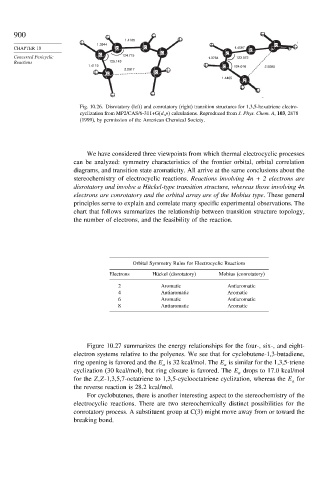Page 916 - Advanced Organic Chemistry Part A - Structure and Mechanisms, 5th ed (2007) - Carey _ Sundberg
P. 916
900
1.4105
1.3944 C
CHAPTER 10 C C 1.4597
C
C C
C 124.715
Concerted Pericyclic 1.3764 123.072
Reactions 125.143
1.4119 C 124.010 2.5080
2.2917
C
C
1.4405
C
Fig. 10.26. Disrotatory (left) and conrotatory (right) transition structures for 1,3,5-hexatriene electro-
cyclization from MP2/CAS/6-311+G(d,p calculations. Reproduced from J. Phys. Chem. A, 103, 2878
(1999), by permission of the American Chemical Society.
We have considered three viewpoints from which thermal electrocyclic processes
can be analyzed: symmetry characteristics of the frontier orbital, orbital correlation
diagrams, and transition state aromaticity. All arrive at the same conclusions about the
stereochemistry of electrocyclic reactions. Reactions involving 4n + 2 electrons are
disrotatory and involve a Hückel-type transition structure, whereas those involving 4n
electrons are conrotatory and the orbital array are of the Mobius type. These general
principles serve to explain and correlate many specific experimental observations. The
chart that follows summarizes the relationship between transition structure topology,
the number of electrons, and the feasibility of the reaction.
Orbital Symmetry Rules for Electrocyclic Reactions
Electrons Hückel (disrotatory) Mobius (conrotatory)
2 Aromatic Antiaromatic
4 Antiaromatic Aromatic
6 Aromatic Antiaromatic
8 Antiaromatic Aromatic
Figure 10.27 summarizes the energy relationships for the four-, six-, and eight-
electron systems relative to the polyenes. We see that for cyclobutene-1,3-butadiene,
ring opening is favored and the E is 32 kcal/mol. The E is similar for the 1,3,5-triene
a
a
cyclization (30 kcal/mol), but ring closure is favored. The E drops to 17.0 kcal/mol
a
for the Z,Z-1,3,5,7-octatriene to 1,3,5-cyclooctatriene cyclization, whereas the E for
a
the reverse reaction is 28.2 kcal/mol.
For cyclobutenes, there is another interesting aspect to the stereochemistry of the
electrocyclic reactions. There are two stereochemically distinct possibilities for the
conrotatory process. A substituent group at C(3) might move away from or toward the
breaking bond.

